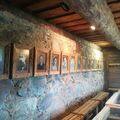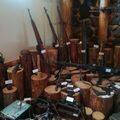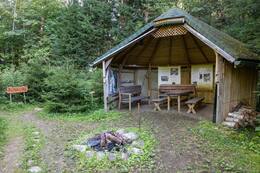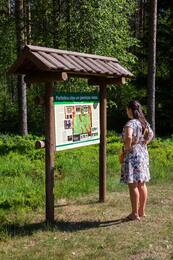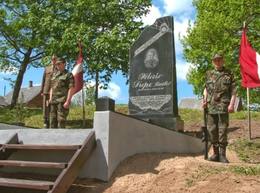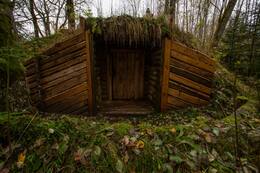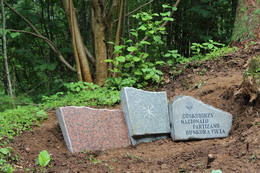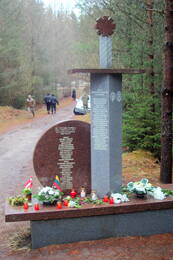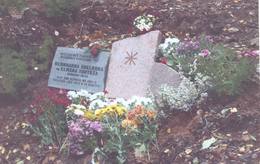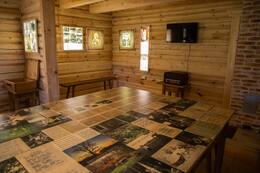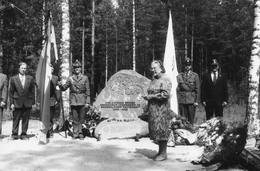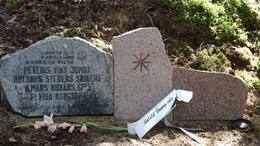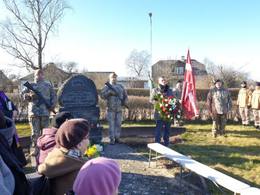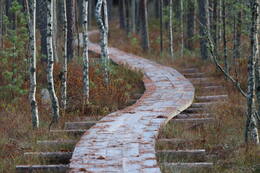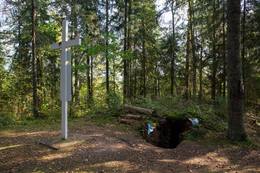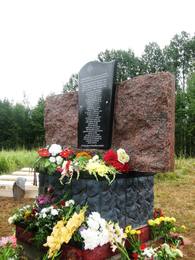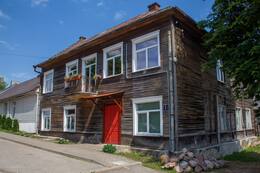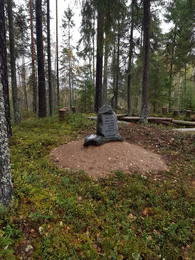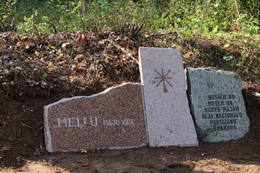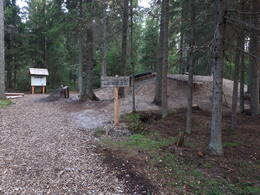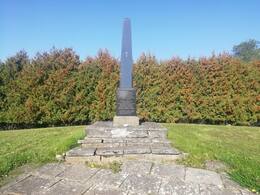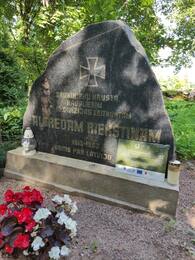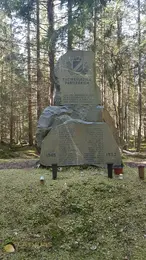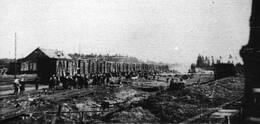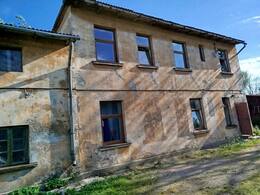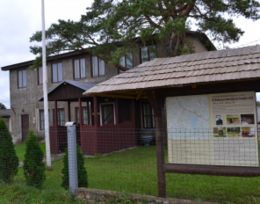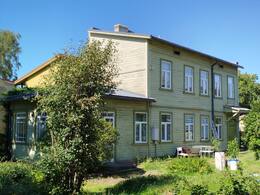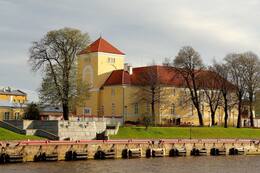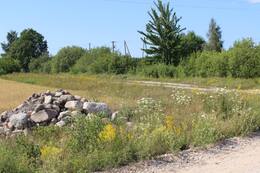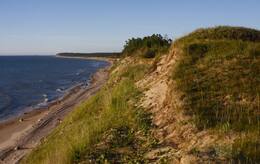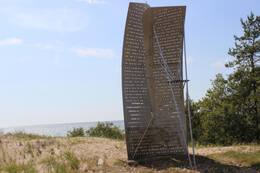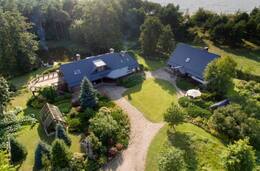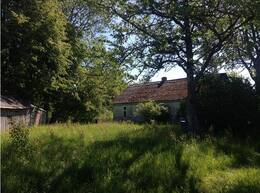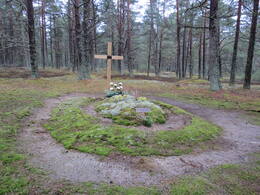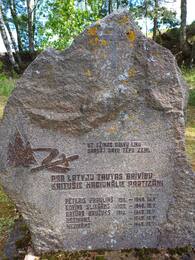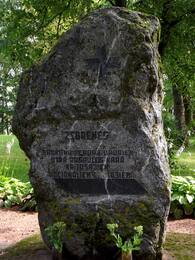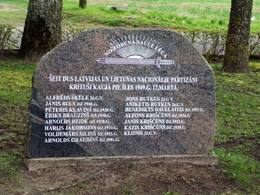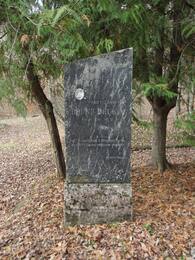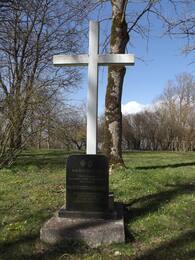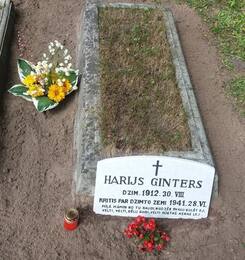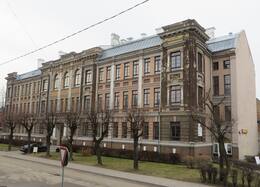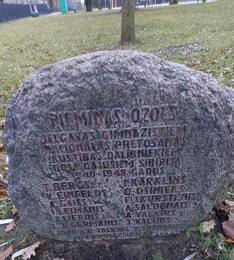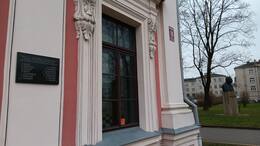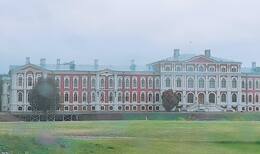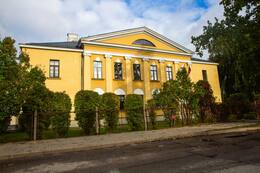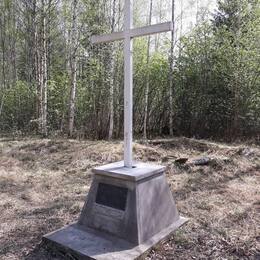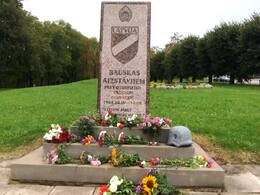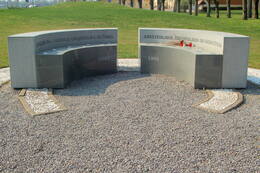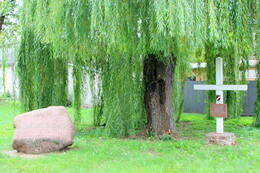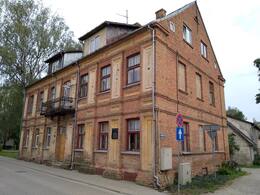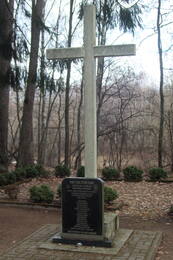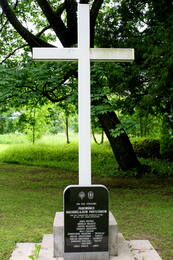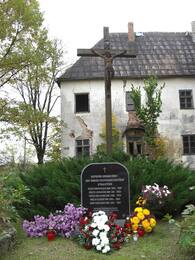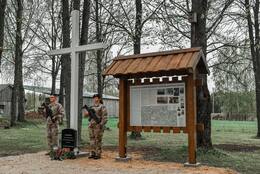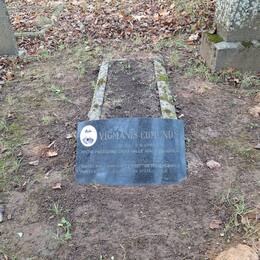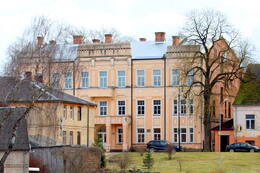National resistance movement
II World War II, IV Soviet Occupation, III National Partizans
The actions taken by the people of the Republic of Latvia to restore the state of Latvia proclaimed on 18 November 1918.
The national resistance movement manifested itself as an armed struggle against one or both occupation regimes, including support for the armed struggle by providing material and other types of assistance, as well as spreading propaganda of the idea of independence of the Republic of Latvia and open opposition to the order and ideology of the occupation regimes.
Related timeline
Related objects
Museum of the National Resistance Movement in Renda
The museum is located a few kilometres from the centre of Renda parish. The exhibit tells about the 50-year-long resistance movement in Latvia: resistance to the first Soviet occupation, resistance to the Nazi German occupation, and the armed and non-violent resistance to the Soviet occupation. The exhibit is located in two buildings. The first building houses evidence of the first Soviet occupation and German occupation. The exhibit showcases a restored barn building where the focus lies on the National Partisan War. Between the two buildings there is a bunker with an authentic layout and trenches used by soldiers. Located near the museum in Renda, excavations, blindages and an obstacle course serve as a training ground for youth guards and anyone interested. Visits must be booked in advance.
One of the largest battles of the national partisans, called the Āpūznieki Battle, took place in January 1946 not far from here. The battle saw the Kabile National Partisan Group overpower much larger forces of the occupying power. Featuring information stands, the battle site is now home to a rest area.
Bunker of national partisans – Forest Brothers
The Forest Brothers’ Bunker is located by the Riga-Pskov (A2) highway 76 kilometres from Riga and 11 kilometres from Cēsis. The Latvian national partisans or Forest Brothers were small, armed groups of local residents who fought their independent battles against the occupation regime of the USSR in the territory of Latvia from 1944 to 1956. Forced to hide in the forests, these were people who could not or did not want to live in the Soviet Union. A total of around 20,193 Forest Brothers operated in Latvia. The bunker was formed based on the stories and memories of former Forest Brothers about life in the forests, hiding and fighting for the independent state of Latvia after 1945. The bunker showcases armaments and household items. The personal belongings, weapons and photos of partisans are on display. The guide’s narration is enriched by a video from interviews with Forest Brothers. There is a place for picnic campfires by the bunker. It is possible to pre-order a soup prepared on the fire or enjoy an evening of outdoor cinema by the fire.
National and Soviet partisan battles and memorial sites in the Grīva Forest
Located in the Grīva forest massif.
Six objects related to the sites of national and Soviet partisan battles can be viewed.
The Grīva forest massif is home to not only the headquarters of the “Purvsaliņi” national partisans, the White Cross in the national partisan bunker and the cross to the commander of the resistance movement Andrejs Roskošs, but also the grave of the commander of the Soviet partisan brigade Artūrs Baložs, a monument on the so-called Meiteņu kalninė, where a group of young partisans of the Soviet partisan brigade perished in 1944, as well as a monument to Soviet partisans with a five-pointed star and the engraved words “We covered ourselves with our needles.”
The objects can also be viewed by going on a bicycle ride on cycle route No. 785 - "Historical Rhymes in the Grīva Forests" (route length 34 km, gravel and forest roads). Map for download.
Memorial to the commander of the national partisan group Andrejs Roskošs (GPS 56.87399, 27.43524)
In the autumn of 1997, a White Cross was unveiled in the Lielgrīva Forest for the commander of the national partisan group, Andrejs Roskoš.
Monument to Artūrs Balodis (GPS 56.872926, 27.478121)
Artūrs Balodis was a Soviet partisan, a special operations commander for the A subunit, which was stationed in the Grīva forest massif. He fell during a large-scale “combing” carried out by the Nazi German occupiers. His comrades carved the letters AB into a birch tree at the place where he died so that he would not forget it. After the war, local historians found the marked birch tree and installed a memorial plaque in its place.
To all those who fell in the Grīva forests (GPS 56.863280, 27.47975)
This memorial stone in the Grīva forest massif has been installed by the State Enterprise “Latvijas valsts meži” in honor of the partisans who fought for their homeland. Next to the memorial stone is a map-scheme with indications of partisan headquarters - sightseeing objects. A recreation area has also been established. Nearby is the site of the national partisan settlement, 1945-1947.
National partisan settlement site (GPS 56.863456, 27.481148)
This place was home to the settlements of national partisans who fought against the Soviet occupation. The sites of individual bunkers have survived, from the visual appearance of which one can judge how large and what shape the dugouts were. National partisans, resisting Soviet rule, operated in the Grīva forests for several years after the end of World War II.
Girls' Hill (GPS 56.858187, 27.521526)
In June 1944, the Nazi German occupiers carried out a large-scale “combing” of the Grīva forests with the aim of destroying the partisans. The soldiers surrounded the farm company on Numerne Hill, which consisted mostly of young girls, and all of them were shot. Since these tragic events, the locals have renamed Numerne Hill as Meiteņu Hill. A memorial stone has been erected at this place.
Monument to the commander of the North-Eastern national partisans Pēteris Supe - "Cinītis"
In honor of the memory of the national partisan commander Pēteris Supe, a monument dedicated to him was unveiled in Viļaka on May 28, 2005. It is located near the Viļaka Catholic Church, on the edge of the trenches dug during the war, where the Chekists buried the national partisans who were shot. Under the monument dedicated to P. Supe, a capsule with the names of 386 fallen national partisans, descriptions of battles and materials about the partisan commander is placed. The words are carved into the stone: "To you, Latvia, I remained faithful until my last breath."
The monument was designed by Pēteris Kravalis.
Nearby is a memorial to the Latvian freedom fighters who fell in Stompaku Forest and other battle sites and were murdered by the Chekists in 1944-1956.
On June 20, 2008, a granite plaque was unveiled on the right wall with the names of 55 fallen partisans arranged in three columns.
The monument was erected at the site where the communist occupation authorities had once exhibited the remains of murdered partisans to intimidate the rest of the population.
On the adjacent plaque are engraved words of gratitude to Pēteris Supe and a poem by Bronislava Martuževa:
"Get up, Peter Supe,
Soul, fight in the war!
Today is your blood sacrifice,
Risen among the people.
Go out and live forever
In the strength and vigor of youth,
It flutters, flutters, flutters
"In the rising flag!"
Memorial site of national partisans in Sērmūkši
Sērmūkši is home to one of more than a hundred memorials to partisan battles in Latvia. There are more than six hundred partisan battle sites in Latvia. A Latvian national partisan dugout has been built based on historical evidence, and visitors can spend the night in near-authentic conditions with plank beds, lighting provided by kerosene lamps and a heating device similar to the ones used by partisans. Visits must be booked in advance. The fateful moment for the Sērmūkši National Partisan Group came on 29 November 1946 with the deaths of four fighters from the group: Jānis Zīrāks, Reinholds Pētersons, Jānis Pīlands and Anna Zariņa. Alfrēds Suipe survived, endured deportation, returned to Latvia and saw the restoration of a free state. He initiated the idea to establish a memorial site for his fallen companions in Sērmūkši.
Memorial stone to the national partisans of Alsviķi parish in "Čūskubirzī"
Located in “Čūskubirzs”, Alsviķi parish, Alūksne municipality.
The memorial stone was unveiled on August 21, 2018. Stonemason Ainārs Zelčs.
Here, in the forest massif, the site of a bunker has been preserved, where in June 1947, Antons Circāns, the head of the communications department of the General Staff of the Latvian National Partisan Association, arrived for a meeting with partisan representatives led by Bruno Bukalders, in order to organize and maintain communications between individual national partisan groups. Antons Circāns' goal was not realized, as he died on July 7, 1947, near Drusti.
Īle National Partisan Bunker
The bunker is located in the Īle forestry of Zebrene Rural Territory, at the turn-off from the P104 Biksti-Auce Road.
The Kārlis Krauja Group of Īle National Partisans was formed in 1947. V. Z. Brizga (alias K. Krauja) was appointed the commander of the group. In October 1948, the Krauja Group merged with a group of Lithuanian national partisans. Krauja Group operated in Jelgava District and consisted of 27 national partisans.
In October 1948, Krauja Group built an underground bunker in Lielauce Parish, Jelgava County, not far from the Īle Forestry, 300 metres to the north of the “Priedaišu” house. Its total length, including battle passages, was 45 metres. 70 remote-controlled mines were planted around the bunker. The bunker was equipped with a furnace, a well, a toilet, and a storage room.
On 17 March 1949, the 24 partisans who were in the bunker at the time fought their last battle against the 760-strong troops of the Ministry of National Security or Cheka. After the battle, 9 members of the group were arrested, while 15 fell in the battle, with eight of them being Latvian and seven being Lithuanian. In 1992, the Home Guards, together with the Daugavas Vanagi (Hawks of the Daugava), unearthed the bunker that had been blown up. A White Cross, a memorial stone and a granite statue were erected at the site.
Inside the bunker, you can see a stove, a table, and narrow benches on which the partisans slept. Information boards and memorial stones with the names of the partisans have been installed at the bunker.
Memorial plaque to the Veclaicene national partisans at the site of the bunker
Located in Veclaicene parish, Alūksne region.
Opened on October 4, 2019. Stonemason Ainārs Zelčs.
On March 13, 1953, in the Veclaicene forests near the "Koruļi" houses, the Chekists discovered a carefully camouflaged bunker and arrested Bernhards Ābelkoks and Elmārs Tortūz.
Weapons were found in the bunker: 2 German rifles and 95 cartridges, 2 “Parabellum” pistols and 152 cartridges.
On November 11, 1949, Cheka agents shot K. Dokti-Dokteniekus, and his group disintegrated. After the attack, B. Ābelkoks and E. Tortūzis hid for some time in a bunker near the “Maskaļi” houses, but from the spring of 1951, with the support of Ilona Ābolkalna, they set up a bunker in “Koruļi”, where they lived until their arrest.
Broņislava Martuževa poetry barn
The Broņislava Martuževa Museum is situated on the site of the poet’s childhood home in Indrāni parish, Madona municipality. The museum’s exhibit is located in a renovated barn featuring voice and video evidence from the National Resistance Movement and the work of the poet in publishing an underground magazine, as well as composing poetry and songs for national partisans. Broņislava Martuževa was involved with the resistance movement since its inception. Lazdiņas, Martuževa’s home which has not survived, also served as a place of refuge for Pēteris Supe, Head of the Latvian National Partisan Association, and his comrades-in-arms. The poet spent five years hiding in the basement of her home, meeting with partisans, writing poetry (including work dedicated to partisans Pēteris Supe, Vilis Toms, Smilga Group, Laivenieks, Salns, Celmiņš, Bruno Dundurs and others), as well as writing songs and teaching them to partisans. Now, her songs are sung by the ‘Baltie lāči’ group (literally: ‘White Bears’). In 1950, the ‘Dzimtene’ magazine (literally: ‘Motherland’) was published underground together with Vilis Toms. The poet transcribed 11 issues of the magazine, 10 copies each, by hand. The poet, her brother, sister, mother and Vilis Toms were arrested in 1951. Bronislava Martuževa returned from Siberia in 1956. Recognised locally and nationally, the poetry barn is visited by both local residents and guests of the municipality. Learning about the poet’s life gives you the opportunity to discover the fate of Latvia.
Memorial to the fallen Latvian Legion soldiers and national partisans
Located in the Lubāna New Cemetery in Indrāni Parish.
A memorial site to the fallen Latvian Legion soldiers and national partisans is open for viewing.
The memorial was opened on July 25, 1992. The memorial stone was created by Andris Briezis.
As the Awakening began, in October 1990, Kārlis Doropolskis, a member of the human rights group “Helsinki 86”, received permission from the authorities to begin the reburial of Latvian legionnaires who had fallen and been buried scattered around Lubāna in the summer of 1944, as well as national partisans who had fallen in later battles with the Soviet occupation troops and security institutions, in common mass graves, which were arranged in the new cemetery in Lubāna. In total, 26 fallen legionnaires and national partisans were buried in mass graves.
Memorial site of the bunker of the national partisan group “Jumba”
Located in Ziemers parish, in the 66th block of the State Forest.
The memorial was opened on July 10, 2020.
In the second stage of the Latvian national partisan movement, in mid-1948, a group of 4 people - Viks Pētersi, Stebers Rolands, Bukāns Ilgmārs and Kangsepa Elvīra separated from the J. Bitāns-Liepačs unit in the territory of Mālupē-Beja parishes and began independent activities in Ziemera-Jaunlaicene-Veclaicene parishes. The partisan headquarters was near the Estonian border, not far from the Riga-Pskov highway, on a hill, in a well-built bunker.
On March 2, 1950, when the Chekists discovered the bunker, the partisans hid in a barn built of boulders in the “Napke” house on the Estonian side. After a long and intense firefight, on March 3, 1950, the Chekists managed to set the barn on fire. Ilgmārs Bukāns, Rolands Stebers, and Elvīra Kangsepa burned to death along with their newborn daughter. Pēteris Viks jumped out of the barn window and hid in the attic of the house, where he was found and shot. The farm was burned down. The bodies of all the fallen partisans were taken to Alūksne. A memorial sign was erected at the site of the fighters’ deaths in the early 1990s. Elvīra Kangsepa’s daughter, who was born in the burning barn, was named Liesma.
National Partisans Memorial Site on Striķu Street, Saldus
The memorial is located at the intersection of Striķu and Lauku Street.
The tragically bloody event that took place at this place took place during peacetime on 24 February 1950 in Saldus, on Striķu (then 5. augusta) Street, near the 33rd and 35th houses. In the 33rd house of this street, after the destruction of the Zemgale group of forest brigades with its headquarters bunker in the forests of Īle in March 1949, three forest brigades were still alive and uncaptured, including the group commander himself, Kārlis Krauja (real name Visvaldis Brizga), and his associate Vilis Krusts. They had hoped to spend the winter of 1950 at the Bergmanis' home in Saldus, but they were rounded up and tracked down. The two houses were besieged by about 30 Chekists and a fierce battle took place early in the morning. The Chekists were fired on from both houses, but, losing to overwhelming odds, the two partisans tried to escape to the nearby Veide forest. However, the Chekists shot partisan Krusta already on the stairs of the house, and Krauja - about 80 metres further towards the forest.
Both houses were set on fire, the occupants having been asked to come out beforehand and promised that their lives would be spared. There are reports that people did come out, but they were shot on the spot anyway. Among the people shot or suffocating in the smoke were the father and son Kursinski from House 35, who had supported the partisans, but also Leontine Ezerkalni, a resident of the Kursinski house, who had no knowledge of her landlord's connections with the forest brigades, was shot.
Trail and partisan memorial in Stompaki bog
During World War II, one of the largest national partisan camps in the Baltic states was situated in Stompaki Swamp. Today, the territory is included in the nature reserve “Stompaki swamp”. The settlement sites located on the islands in the swamp can be reached via a marked footpath.
In early 1945, about 350 to 360 people, including 40 to 50 women, lived at the camp of National Partisans in Stompaki Swamp. The camp consisted of 24 residential bunkers – buildings that were half-immersed into the ground and could accommodate 3–8 people. There was a bakery, a church bunker and three above-ground rails for horses. Partisans from the camp carried out attacks against officials of the occupation regime. On 2–3 March 1945, the Battle of Stompaki took place here – the largest battle in the history of Latvian national partisans. The 350–360 partisans in the camp were attacked by the 143rd Rifle Regiment of NKVD and local fighters of the so-called ‘istrebitel’ (eliminators) battalion – 483 men in total. The battle lasted for the entire duration of the day on 2 March. On the night of 3 March, the partisans managed to break out of the camp and retreat to their previous base camps. The battle resulted in 28 casualties among partisans, while the NKVD force lost 32 fighters.
Today, the site of the Stompaki camp is home to three restored bunkers – a church, a headquarters and a residential bunker – as well as 21 sites of former bunkers. Information boards about the camp and the battle have been installed at the site. Guided tours can be booked.
Partisan Dugout Shelter of Veseta and “White Cross” Memorial Site
The Veseta Partisan Dugout and the “White Cross” memorial site are located in the Veseta floodplain swamp.
After the Second World War, the so-called Pārups Group was operating in Vietalva. Rihards Pārups (1914–1946) was the leader of the group. During the Second World War, he was a sergeant of the 15th Latvian Division of the German Army. He participated in national partisan operations in the vicinity of Jēkabpils and Madona. During its short existence, Pārups Group took part in more than 20 armed clashes with the units of the Ministry of the Interior of the time.
The Colonel Kotov of Cheka, in his report to his superiors in Riga, indicated that, as a result of the activities of the group, the Soviet authorities in the Jēkabpils and Madona districts were paralysed. National partisans led by Pārups found and destroyed several deportation lists, thus saving the lives of multiple people. Unable to destroy the national partisan unit in open combat, the leadership of the Soviet Security Committee infiltrated four members of the Cheka special force into the group. On the night of 2 July 1946, these agents shot ten partisans of the unit, including Rihards Pārups. The burial place of the fallen is unknown, but a commemorative plaque has been erected at the Brothers’ Cemetery in Riga to commemorate them. The “White Cross” memorial site is situated next to Veseta Partisans Dugout. It is a 3-metre-high white cross with a plaque inscribed with the names of partisans who fell on 2 July 1946.
Monument to the participants of the resistance movement in Stompaki
Located 15 km from Balvi in the direction of Viļaka, on the right side of the road.
A memorial sign is visible.
A memorial to the participants of the resistance movement, dedicated to the memory of the national partisans of Pēteris Supe who fell in the battles of March 2 and 3, 1945, was unveiled on the side of the Balvu - Viļakas highway opposite the Stompaku swamp on August 11, 2011, on the Day of Remembrance of Latvian Freedom Fighters. At the end of July, a capsule with a message for future generations was embedded in the foundation of the monument. A document with the names of 28 national partisans who fell in the battles of March 2 and 3, 1945 is placed in the capsule.
"In February 1945, on the islands of the Stompaku swamp, which the people began to call the Stompaku swamp islets, 2 km from the Balvi - Viļaka highway, the largest national partisan camp in Latvia was established, where 360 people lived in 22 dugouts. Among them were some legionnaires who, when the legion division retreated, had remained at their father's house with all their weapons. In order to destroy the partisans, on March 2, 1945, soldiers from two Cheka battalions attacked the dugouts together with destroyers, who also had four mortars in their armament. The fighting lasted all day, the partisans resisted stubbornly, and the attackers suffered heavy losses, so that they were unable to take the camp and destroy the partisans. 28 residents of the Stompaku swamp had also fallen in the battle or died from serious injuries. The next night, the partisans broke through the camps with a battle "the siege and left undefeated" - this is what Zigfrīds Berķis, the chairman of the Commission for the Affairs of the National Resistance Movement Participants of the Awards Department, writes about the Battle of Stompak.
Private Exhibition “Abrene Rooms”
The Private exhibition “Abrene Rooms” is located in the town of Viļaka, in a building with a diverse history. Initially, the building was located on the old Marienhausen market square, later it housed apartments, offices and various shops, and during World War II, it was the Latvian self-defence headquarters, the Gestapo and also the Cheka. Several exhibitions reveal diverse events and historical periods in the town of Viļaka and its nearest vicinity covering the time period from 1920 to 1960 when Viļaka was part of Jaunlatgale, later Abrene, district. The exhibit features items from the national partisan camp in Stompaki Swamp, which are related to the national partisan movement in the Latgale region. Documents and photos associated with the War of Independence are also on display. The latest exhibition is dedicated to the once-famous motocross track “Baltais briedis”.
Memorial site "Bitāna Bunkers"
Located in Mālupe parish, Alūksne municipality.
The memorial stone was unveiled on October 13, 2017. Stonemason Ainārs Zelčs.
On August 24, 1945, in Latgale, in the Dubna forests, the Latvian National Partisan Association (LNPA) was founded with the aim of restoring the 1918 Republic of Latvia. For better coordination of the activities of the partisan groups, regional headquarters were established. The national partisan groups operating in the Beja, Mālupė, and Mārkalne parishes united in the “Priedolaine” sector. The regional headquarters was headed by Jānis Liepacis. Propaganda departments were established in each regional headquarters. One of these, commanded by Jānis Bitāns, was established in the forest massif of Mālupė parish. Here, in the bunker, from 1946 to 1948, five press publications of the Latvian National Partisan Association were printed: “Mazais Latvis”, “Liesma”, “Auseklis”, “Māras Zeme” and “Tautas Sargs”. The Alūksne Gymnasium youth resistance movement “Dzimtenes Sili” was involved in the preparation and dissemination of information.
Memorial stone in Ilzene near the houses of “Sarvi” and “Meļļi”.
Located in Ilzene parish, Alūksne municipality.
The memorial stone was unveiled on September 28, 2018. Stonemason Ainārs Zelčs.
The residents of these houses in Ilzene parish from the autumn of 1944 supported the national partisans led by Voldemars Andersons (“Vecs”), whose bunker was located nearby in the thicket of the forest. On November 23, 1945, the bunker was surrounded by NKVD soldiers. Nine fighters died in the battle. After it, 2 machine guns, 14 automatic rifles, 11 rifles, 10 pistols, 3,500 cartridges, 45 grenades, 4 binoculars were found. The destruction of Voldemars Anderson’s group was planned in the Cheka agency’s case “Chain” (“Цепь”).
The group consisted of Voldemārs Pāvels Andersons ("Vecais"), Gastons Dzelzkalējs, Voldemārs Tonnis, Centis Eizāns, Osvalds Kalējs, Jānis Koemets, Stāvais ("Polis"), Voldemārs Rappa, Eduards Rappa, Elmārs Rappa (remained alive).
Pēteris Čevers national partisan bunker
The bunker of the national partisans of Peter Chever is located in Lauciene municipality, about 4 km from the Talsi-Upesgrīva road. A trail covered with wood chips leads to the bunker. The renovated 31 square metre bunker is made of a concrete frame finished with half-logs of logs to create an authentic feel.
Captain Chever's group completed the bunker in the forest near Vangzene at the end of October 1949. It was planned to survive the winter of 1949-50. On 3 February 1950, the local forester betrayed the partisans and the bunker was attacked by a Cheka unit of more than 300 soldiers. At that time there were 19 people in the bunker - 17 men and two women. Six partisans fell in this unequal battle, but the others managed to break through two chains of Cheka siege by fighting their way through. By the end of the winter the partisans took refuge in surrounding houses with their supporters, but in the spring the group reunited until it was captured and destroyed in November 1950. After an attack by Cheka troops, the bunker was blown up and before it could be rebuilt, only a water-filled pit remained.
Zlēku Tragedy Memorial Site
The memorial is located near the Zlēki Manor ensemble, in the western part of Karātavkalns. Around twenty boulders with the names of the people killed form a circle, and in the centre is a black marble obelisk about three metres high.
Some of those killed have been reburied at the Zlēki memorial.
In December 1944, in the vicinity of Zlēki, the German Nazi army carried out a large-scale operation against the civilian population.In the combat action log of Army Group Nord, an entry was made at 17.30 on 9 December 1944 that 161 people belonging to the "Rubens Brigade and units of the Red Arrow" had been killed on the enemy side during the action. In Soviet times, this figure was apparently taken as the total number of victims of the Zlēki tragedy, referring to civilians killed.
The course of the action is partly documented in the report of the head of the counter-intelligence section of the German 16th Army of 31 December 1944. It explains that from 5 to 9 December, under the leadership of the highest SS and police leader in Ostland, SS Oberruppenführer and Police General Friedrich Jekeln, a large-scale operation took place at Eichensumpf ("Oak Swamp") against the "Red Arrows" and the remnants of General Kurel's group at Abava.
Grave of the National Partisans "Dzelzkalni" Brothers
A monument to the memory of national partisans has been erected in the cemetery. The names of the partisans who served in the Puze-Piltene partisan group are carved into the stone. The granite slab at the foot of the monument has the numbers of the year (1945-1953) and the names of 36 fallen partisans engraved on it.
On February 23, 1946, a bloody battle took place in Tārgale parish near Vārnuvalkas between the Latvian national partisan group led by commander Brīvnieks at their camp site and the destroyer unit of the Soviet occupation army. Six partisans fell in the battle, who were secretly buried by local residents in the forest there. Later, two more who were shot were buried there without trial or sentence. Locally, this corner of the forest was called the Dzelzkalns Cemetery, which for many years only connoisseurs were able to find – by the sign of the cross in the spruce.
In the summer of 1989, members of the Ugāle branch of the Latvian National Liberation Army (LNNK) placed birch crosses at the national burial site of the Puze-Piltene group of those who fell on February 23, 1946, in the Dzelzkalni area of the Zūri forest, and searched for relatives of the fallen in Latvia and abroad.
On April 27, 1991, with the participation of relatives of the fallen and representatives of national organizations from several countries, the graves were consecrated by theology professor Roberts Akmentiņš, and they were named the Dzelzkalni Brothers' Graves.
Stende railway station in narrow gauge railway network and the memorial stone for deportations
The railway line Ventspils - Mazirbe, as well as the Stende - Dundaga extension to Mazirbe with a branch to Pitrags, were intended only for strategic military needs. During the construction of these lines, and afterwards, all civilians were evacuated from the region. The main task of the military railways in the Irbe Strait area was to provide the German army's coastal defence positions with guns and ammunition.
These military-only military railways also connected the three most important lighthouses, located in Oviši, Mikeltornis and Šlītere.
Nevertheless, passenger transport was also provided as early as the years of World War I.
A memorial stone (1989) to the deported Latvians of 1941 and 1949 is located at the Stende railway station.
On 30 October 1919, Stende railway station was occupied by Bermont troops. On 17 November, soldiers of the Latvian army led by K. Šnēbergs attacked the station, driving away a wagon with weapons, war materials and grain. 6 soldiers were awarded the Order of the Order for these battles: K. Bumovskis (1891-1976), P. Strautiņš (1883-1969), R. Plotnieks (1891-1965), E. Jansons (1894-1977).
The building in Ventspils where LCP liaison Valentine Jaunzeme (Lasmane) lived in 1944
The house at Lauku Street 4, Ventspils, was home to the teacher Valentīne Lasmane (nee Jaunzeme) (1916–2018). She was a liaison officer for the Latvian Communist Party and a member of the Ventspils liaison group. After World War II, she lived in Sweden.
She compiled the testimonies of 130 boat refugees in the publication “Across the Sea 1944/1945” (Stockholm, 1990), but V. Lasmane's own life story can be read in the book “Night is No Longer Just for Sleeping” (Riga, 2020). In 2000, she was awarded the Order of the Three Stars. She died at the age of 102 in 2018 in the Stockholm suburb of Täby.
Rubenis' battalion museum
Rubenis’ Battalion Museum is located in Ugāle. It is dedicated to the Battalion of R. Rubenis, who served and fought under General J. Kurelis in Kurzeme in 1944, the activities of the Kurelians and the national resistance movement. Museum has an exhibit on the activities of the Latvian Central Council (LCC) and its Ventspils group, as well as the LCC Memorandum with 188 signatures and photographs of signatories that is included in the Latvian National Register of the UNESCO Memory of the World Programme. The LCC was a joint centre of Latvia's highest political leadership with an underground government that operated during the occupation of Latvia from 1943 to 1994. It was formed with the aim of coordinating the activities of various Latvian resistance movements in order to restore Latvia's national independence. The museum also offers a trip to places significant to the history of the battalion (settlement with a reconstructed bunker in the Usma parish, battlefields in Renda and Zlēkas parishes, etc.).
The building in Ventspils where Dr. Valdemārs Ģinters, a representative of the Latvian Communist Party and organizer of refugee boat traffic in Kurzeme, lived in 1944-1945.
The house at Katrīnes Street 4, Ventspils, where archaeologist Valdemārs Ģinters worked.
From October 1944 to May 8, 1945, the LCP representative in Kurzeme was archaeologist Valdemārs Ģinters (nicknames “Doctor”, “Gardener”) (1899–1979). Participant in the Latvian War of Independence, director of the State Historical Museum and docent at the University of Latvia. Awarded the Lāčplēsis War Order and the Three Star Order. One of the signatories of the LCP memorandum of March 17, 1944. After World War II, he lived in Sweden. From 1949 to 1979, he was chairman of the board of the Latvian National Foundation.
Prison in the Livonian Order Castle during World War II
Several members of the LCP Ventspils communications group and refugee boat operators were detained in the prison established in the Livonian Order Castle in 1944-1945.
Memories of the boatman Žanis Fonzovs: “Two boats left Sweden - “Krīvs” and “Zvejnieks”. I was on “Zvejnieks”, and the crew included Saulīte and Grunti. [..] The weather was beautiful, I was sailing so inconspicuously, not very high. I immediately saw - I was in Morse code. The boat was approaching. I went down to the engine room, because in addition to Saulīte's papers, I also had letters from the arrivals to relatives in Latvia and the collected weapons in a bag. I threw the letters and papers into that bag of weapons and everything overboard.. What then! The boat approached ours and the Germans asked for our driving permits. [..] So on October 21, the Germans took us with the entire “Zvejnieks” to Ventspils. They took us to prison. There were about 30 people in the room. I had a sheepskin coat on my back, I put it on the floor and put it on myself, but I had not slept last night. On the second or third day, they called us out for questioning. We had agreed to say that we were refugees on our way to Germany. I had just wanted to go to Lielirbe to follow my friend. It seems that they believed us then. [..] But then the situation in Ventspils changed: the city was taken over by the military administration, and we were called in for questioning a second time. It was worse, because they showed us a box of Swedish matches and a piece of kroon that were allegedly found on the boat. One of the interrogators was a Latvian, and he even beheaded us for telling the whole truth. We saw that the fairy tale had ended, we simply had to confess.
The road to the "Grīnieki" house in Vārve parish
The road to the “Grīnieki” houses in Vārve parish, where in 1944 one of the main settlements for boat refugees on the Kurzeme coast was located.
Memories of boatman V. Jurjakas: “Entering the “Grīnieki” yard, everything looks very normal. A quiet country house, not a soul, probably people in the sun. [..] It turned out that not only the “Grīnieki” residential house was full of people, but all the buildings were full. The barn, the granary, the hayloft and the bathhouse. I met one or two acquaintances, because it was time to leave our land. [..] The nutritional situation was not critical, but quite poor. [..] In the evening, the refugee caravan began to move towards the seashore. I warned everyone in advance not to come out of the bushes by the seashore, because there were coast guard dugouts and observation posts nearby. It was a large caravan, because about 200 people were going to the seashore. There was no hope that everyone would arrive on time. The evening was not very dark, and I was able to review the activities of the entire group. The most striking were the large "When people lived in "Grīnieki", they didn't see them, but now, when they were brought into the light, they only saw this. The goods alone required a whole boat. 3-4 two-horse carts were loaded with goods, followed by people. [..] We waited for the boat for a long time, but it didn't come. The whole caravan had to turn back. It was very dark."
Temporary refugee shelters "Vārves būda"
"Vārves būdas", a place in Ventspils municipality that served as temporary housing for Latvian refugees who were waiting for boats from Gotland to arrive in 1944.
Memories of the boatman V. Jurjaks:
“My half-brother and his family had come to us from Riga, and when the news came that a boat was expected at Vārve, I united these people of mine with the group of police chief Jasūnas and we all set out for Vārve. We waited for the signals until late at night, but the boat did not arrive. We waited there like that for a whole week. It started to rain. People made tents out of sheets, so we called this place “Vārve huts”. My wife and I spent more time in Ventspils during the day, and eventually we had to think about how to deliver food to those waiting. I remember one night my wife and I were carrying hot boiled potatoes through the forest for them on our bicycles. It was raining heavily, lightning was roaring, and the warm potatoes tasted good to the waiting people who had spilled out. The Vārve forester had accidentally discovered this hiding place, but - promising him the possibility of a transfer, he came to help. The Germans had begun to go through the houses of the coastal residents, looking for people in the years of conscription. Two young people had been caught in the forest near the “Vārve huts”. Therefore, this place could no longer be safe for these more than fifty people who were languishing here.
Memorial sign for refugees "Sail of Hope" in Jūrkalne
The "Sail of Hope" commemorative sign for the World War II refugees who crossed the Baltic Sea by boat to the island of Gotland in Sweden in 1944 and 1945. The memorial is located in Osvalki on the dunes between the sea and Ventspils-Liepaja highway, near the public transport stop "Kaijas". It was created by sculptor Ģirts Burvis, who realised it as a sail of hope symbolising the memory of Latvian refugees.
Between autumn 1944 and spring 1945, fearing the renewed Soviet occupation but unwilling to evacuate to a devastated and threatened Germany, some Latvian citizens tried to reach the nearest neutral country, Sweden, by sea. Some of the boats were organised by the Latvian Central Council with the help of the Western Allied countries, which resulted in one of the largest refugee concentration points in Jūrkalnes parish. Besides the boats organised by the Latvian Central Council, other boats were also taken across the sea. It is estimated that about 5000 persons managed to cross the sea. The number of deaths is unknown, as no records were kept of refugees leaving the Kurzeme coast.
The voyages were dangerous because the refugees were threatened by German patrols on the coast and at sea, sea mines, Soviet aircraft and warships, as well as storms, as the crossings often took place in unsuitable and overloaded cutters and boats without sufficient fuel and food supplies, sea charts and navigational instruments. Departures from Latvia were carried out in secret. The destination of the boats was the island of Gotland, and the journeys most often started on the west coast of Courland (from Jūrkalne to Gotland is 90 nautical miles or about 170 kilometres as the crow flies).
"Bambaļi" houses - one of the main accommodation places for boat refugees
The restored “Bambaļi” houses in Ošvalki, Jūrkalne parish, which in 1944 was one of the main places of accommodation for boat refugees on the Kurzeme coast.
Memories of boat refugee Kārlis Draviņš: ““Bambaļi” were old, small, very run-down houses in Jūrkalne parish, about 40 kilometers from Ventspils. [..] Small fields spread around in a damp place, but on the other side an old, overgrown dune wrapped itself around it. The sea gurgled a little behind it - the houses were right next to the sea. On the other side, half a kilometer away, the Pāvilosta-Užava highway ran, but the road to the houses was not easy to drive on, which is why the Germans could not be everyday guests here. The place where boats were waiting was easily accessible - a small forest clearing on a high bank. [..]
The owner of "Bambaļi" and her group, who were also waiting for the "movement of the water", lived in two rooms facing the sea, but the group of refugees lived at the other end of the house, also in two rooms. They shared the kitchen. The hallway between the two ends was stuffed with the refugees' many belongings. The rooms were filled with straw, which was spread out along the walls. On each side of the room was one bed, where a mother and her children slept. The straw beds were covered with sheets or something else during the day. They came out to sit or sleep in them during the day, because there was nowhere else to stay. [..] The days passed monotonously, one after the other. They got up on command, there was no hurry. When the communal breakfast was eaten, some went to play cards, some took up fortune-telling, while others tried to read. Some had to do household chores - fetch firewood, water.
"Laukgaļi" houses, the residence of the writer Kārlis Skalbe
“Laukgaļi” in Jūrkalne parish, the place where writer Kārlis Skalbe stayed in October - November 1944, while waiting for a refugee boat to Sweden.
Writer Kārlis Skalbe (1879–1945) was a member of the Latvian Provisional National Council and the Latvian People's Council, a deputy of the Constitutional Assembly of the Republic of Latvia and the 1st and 4th Saeima. During the German occupation, he was the editor-in-chief of the literary magazine "Latvju Mēnešraksts", one of the signatories of the LCP memorandum of March 17, 1944.
On November 11, 1944, she fled to Sweden. She died in 1945 in Stockholm.
Lithuanian soldiers' graves in Zaļkalns Forest
The memorial is located near the Pāvilosta beach lookout tower in the dunes. There are signs pointing to the memorial.
At the end of the Second World War, three Lithuanian police battalions, the 5th, 13th and 256th, were also deployed in Latvia, and after guard duty and fighting against Soviet partisans and the Red Army on the Eastern Front, from autumn 1944 they were involved in guarding the Baltic Sea coast in Kurzeme.
In October 1944, all three battalions, consisting of 32 officers and about 900 instructors and soldiers, were subordinated to the German 18th Army's 583rd Rear Guard Unit (Koruck 583). The unit was tasked with guarding the Kurzeme coast from Liepāja to Ventspils. All three Lithuanian battalions were deployed in the vicinity of Pavilosta. In December 1944, the 13th Battalion was transferred to the German 1st Army Corps at the Liepaja Lake.
One of the tasks of the Lithuanian coastguard, besides being ready to fight enemy landings and to report enemy ships, was to prevent Latvian refugee boats from sailing to the island of Gotland, 160 kilometres away, but the Lithuanian coastguard men did not prevent the refugee boats from leaving. However, news of the Lithuanian coastguard helping the Latvian refugees and the Lithuanians themselves preparing to cross the sea to Sweden also reached the Germans.
On 10 January 1945, the soldiers of the 1st Company of the 5th Lithuanian Police Battalion were rounded up. More than a week of interrogation and trial followed, which, as a warning to the others, decided to execute seven of the Lithuanian soldiers and to imprison 11 of their comrades in concentration camps in Germany. The execution of the seven Lithuanian soldiers (Sergeant Macijauski, the company commander; Juozas Sendrjuas, a soldier; Vladas Salickas, a soldier; Ionas Bašinskis, Krasauskas and two unknown others) took place on 21 January 1945 in the Zaļkalns Pines in Pavilosta.
In January 1945, the 5th Battalion was disbanded and the combat-ready soldiers were divided into the two remaining battalions, while the rest were formed into a separate sapper company. At the time of the surrender of Army Group Kurzeme in May 1945, two battalions (13th and 256th) were still in Kurzeme as a sapper company with a total of 900 soldiers who were taken prisoner by the Soviets.
Memorial site to the members of the P. Prauliņš national partisan group and the site of the bunker
Pēteris Prauliņš (1911-1949) Birži parish national partisan group was part of the group led by Mārtiņš Pokļevinskis (1902-1951). The group carried out several partisan actions, in which Soviet collaborators were punished and food and property of the economic institutions of the occupation authorities were requisitioned. P. Prauliņš's group partisans did not observe sufficient conspiracy, many persons visited their settlement, which created an opportunity for betrayal. The lack of military experience was one of the shortcomings of the partisan armed movement.
P. Prauliņš's partisan group in the Kalna forest in the Birži parish was destroyed on May 16, 1949, during an operation by the Ministry of State Security of the Latvian SSR, in which military units also participated. The forest brothers had set up a bunker with perimeter defense, which was well camouflaged and was located at an undetermined height in a swampy area. The partisans fiercely resisted the Cheka troops for at least 40 minutes, but the entire group fell: Pēteris Prauliņš, Artūrs Bružuks, Jānis Kalvāns, Edvīns Slikšāns and Francis Skromanis. The shot forest brothers were thrown near the parish house, but their remains were later buried in nearby gravel pits. Irma Bružuka was seriously wounded, who was captured and died on May 17 in Jēkabpils Hospital. She was buried outside the cemetery, but when the cemetery was expanded after Latvia regained its independence, a monument was placed on her grave.
A memorial stone to the partisans of P. Prauliņš' group in Kalna parish was consecrated in November 1998. The site of P. Prauliņš' bunker is located in section 4 of Vidsala 99th block, Kalna parish. The stone on which P. Prauliņš sat has been preserved.
Memorial to the victims of the struggle against the Soviet occupation and communist repression in Zebrene parish
A memorial to those who fought against the Soviet occupation regime and the victims of communist repression in the Renģe Manor Park of Zebrene Parish was opened on September 1, 1995. A cross is depicted on a rough boulder and the words are engraved: “To the victims of the Zebrene red terror, to the national fighters who fell in World War II.” The creation of the memorial was financially supported by the organization “Daugavas Vanagi”.
The Brothers' Cemetery of the Īle National Partisans in the Virkus Cemetery, Bērze Parish
The Īle National Partisan Brothers' Cemetery in the Virkus cemetery of Bērze parish was established on November 14, 1992, when 15 partisans who fell in the Battle of Īle on March 17, 1949, were buried here. This was possible after on July 18, 1992, the National Guard, together with the organization "Daugavas Vanagi" and the Latvian history research working group "Ziemeļblāzma", with the participation of representatives of other nationally-minded organizations, exhumed the remains of 15 Latvian and Lithuanian forest brothers buried in a blown-up partisan bunker in the Īle forest district of Zebrene parish.
The memorial stone to the national partisans who fell in the Battle of Īle was unveiled on May 29, 1993. It was designed by Alfons Kalniņš ("Edgars"), one of the surviving participants in the battle of March 17, 1949. The regular-shaped granite slab depicts a sword and a rising sun, and is engraved with the names of 15 fallen national partisans and the inscription:
“The sun rose from the sword. Here lie the Latvian and Lithuanian national partisans who fell in the battle of Īle on March 17, 1949.”
The gravestone of the national partisan Bruno Druķis, who fell in 1941, in the Jaunsesava cemetery, Naudīte parish
Gravestone for Bruno Druķis, a national partisan from Naudīte parish, who fell in a clash with the armed formations of the Soviet occupation authorities on June 30, 1941. A granite stele with the text: “To the partisan Bruno Druķis. Fell on June 30, 1940. This land is a sacred heritage for our people. And blessed is he who falls for him. Naudīte parish”. The ceramic medallion with the portrait of B. Druķis was smashed and destroyed after World War II.
After the start of the German-USSR war, about ten local guards gathered in the Ružēni forest on June 27, 1941 and formed a national partisan unit with Žanis Gelsons at the head. The next day, the partisans occupied the Naudīte parish executive committee and the local machine and horse rental station, taking possession of the tractors, agricultural equipment and horses there. On June 30, the Naudīte partisan unit tried to intercept a column of Red Army soldiers led by two officers on the road near Meļļi. During the clash, both Soviet officers and retired corporal Bruno Druķis of the Latvian Army Cavalry Regiment fell.
Memorial to Latvian and Lithuanian national partisans in Ukru parish
The memorial site for Latvian and Lithuanian national partisans near the former Ukru parish school was opened and consecrated on October 21, 2006. A white cross has been erected there, at the foot of which there is a granite stele with the names of two Latvian and two Lithuanian national partisans engraved and the text: “For You, Fatherland. To the national partisans of Ukru parish 1944-1954. In the fight against the communist occupation regime on October 26, 1948, Eidis-Eduards Ozols, Kristaps Siļķe, Alfonsas Bugnius, Kostas Norvaitis fell in Ukru parish”.
The memorial site was established by the Latvian National Partisan Association (LNPA) in cooperation with the Lithuanian Freedom Fighters Association (LLKS). Its opening was attended by the chairman of the Ukru Parish Council Ainārs Āriņš, the chairman of the LNPA Ojārs Stefans, the representative of the LLKS Jons Čepons and other attendees.
The gravestone of the national partisan Harijs Günters, who fell in 1941, in the Ūziņi Prieži cemetery in Zaļenieki parish
Gravestone for the national partisan of Jēkabnieki parish, Harijs Ginter, who fell on June 28, 1941. A plaque is installed on the grave with the text: “Harijs Ginter. Born 1912.30. VIII. Fell for his native land 1941.28.VI. Dear mother, What you cry, extinguish the scale, go to sleep,. In vain, in vain, wait for your son, in vain do you shed bitter tears”. The gravestone was restored in 2016 and 2024 at the initiative of Gunita Kulmane, the head of the Ūziņi library of Zaļenieki parish, and at her personal expense.
In the days following the outbreak of the German-USSR war on June 22, 1941, a national partisan unit was formed in Jēkabnieki parish to ensure order and end the Soviet occupation power, with the commander of the guard platoon V. Ritums at the head. Initially, the weak armament – a few pistols and rifles – was supplemented with trophy weapons from the Red Army soldiers captured near Kalnanši and in other places. A major clash with Soviet armed formations took place on June 28, 1941 in Gudēni, where the guard of Jēkabnieki parish and national partisan H. Ginter was captured and tortured to death.
Memorial to the participants of the resistance movement of Jelgava 1st Secondary School repressed by the Soviet occupation regime at Meiju Street 9
The memorial site for the members of the Jelgava 1st Secondary School youth resistance organization repressed by the communist regime in 1941 was established in 2007 at the initiative of socio-political activist and historian Andris Tomašūns. At the memorial site near Jelgava 1st Gymnasium (now Jelgava High School of Technology), an oak tree has been planted and a boulder has been placed with the following text engraved on it: “Memorial oak tree to Jelgava gymnasium students, participants in the national resistance movement – those who died in Siberia in 1940-1948. T. Bergs, V. Einfelds, A. Gaišs, I. Leimanis, J. Liepiņš, J. Jegermanis, I. Kārkliņš, O. Ošenieks, F. Skurstenis, A. Saldenais, A. Valkīrs, J. Valūns. 2000. O. Valkīrs, V. Treimanis and 1st Gymnasium”.
The Jelgava student resistance organization “Free Latvia” was secretly founded on September 30, 1940, by six 11th grade students of Jelgava 1st Secondary School in the apartment of Fričas Skurstenis at 11-4 Slimnīcas Street. The organization was led by Juris Valūns and its members numbered about 20 people. They gathered in illegal meetings where they discussed the organization’s structure and activities. The young people printed the anti-Soviet slogan “Get ready!”, 100 copies of which were pasted around the city on October 14. From October 25, 1940 to November 6, Soviet security authorities arrested thirteen students of Jelgava 1st Secondary School, who were imprisoned in Jelgava prison and interrogated for a long time. 1941. In 1942, the detainees were taken to the USSR, where on February 7, 1942, the Special Meeting of the USSR People's Commissariat of Internal Affairs sentenced them to 10 years in prison. Only Voldemārs Treimanis survived and returned to Latvia, while the other members of the resistance organization of Jelgava 1st Secondary School died in the Gulag camps in 1942-1943.
Memorial plaque to the resistance members of Jelgava 1st Secondary School repressed by the Soviet occupation regime at Akademijas Street 10
A memorial plaque to the members of the youth resistance organization of Jelgava 1st Secondary School (previously Hercogs Pēteris Gymnasium) repressed by the communist regime was installed by the Jelgava branch of the Latvian Politically Repressed Association on October 24, 1996. Initially, the plaque was located inside the Ģ. Elias Jelgava History and Art Museum, but after the renovation of the building's facade and premises in 2007-2008. it was moved to the outer wall of the museum to the right of the main entrance, alongside memorial plaques dedicated to other historical figures. The text engraved on the plaque reads: “On 26 October 1940, students of the Hercogs Jēkabs Gymnasium arrested and deported to Siberia – members of the anti-Soviet movement “Free Latvia” T. Bergs, V. Einfelds, A. Engurs, A. Gaišs, J. Jegermanis, I. Kārkliņš, I. Leimanis, J. Liepiņš, O. Ošenieks, A. Saldenais, F. Skurstenis, V. Treimanis, A. Valkīrs, J. Valūns.”
The Jelgava student resistance organization “Free Latvia” was secretly founded on September 30, 1940, by six 11th grade students of Jelgava 1st Secondary School in the apartment of Fričas Skurstenis at 11-4 Slimnīcas Street. The organization was led by Juris Valūns and its members numbered about 20 people. They gathered in illegal meetings where they discussed the organization’s structure and activities. The young people printed the anti-Soviet slogan “Get ready!”, 100 copies of which were pasted around the city on October 14. From October 25, 1940 to November 6, Soviet security authorities arrested thirteen students of Jelgava 1st Secondary School, who were imprisoned in Jelgava prison and interrogated for a long time. 1941. In 1942, the detainees were taken to the USSR, where on February 7, 1942, the Special Meeting of the USSR People's Commissariat of Internal Affairs sentenced them to 10 years in prison. Only Voldemārs Treimanis survived and returned to Latvia, while the other members of the resistance organization of Jelgava 1st Secondary School died in the Gulag camps in 1942-1943.
The building of the Agricultural Academy in Jelgava at Lielāja Street 2, where members of the Latvian Central Council worked in 1943-1944
Several members of the academic unit “Austrums” and the Central Council of Latvia, secretly established in Riga on August 13, 1943, worked at the Agricultural Academy in Jelgava (Mītava) (today - the Latvian University of Biosciences and Technologies) in 1943-1944 - professors Rūdolfs Markuss, Andrejs Teikmanis, Alfrēds Tauriņš and other teaching staff. On March 10, 1944, Vilis Eihe, an assistant professor at the Agricultural Academy, together with his wife Aleksandrs and assistant Hermanis Zeltiņš, printed the LCP’s illegal newspaper “Jaunā Latvija” in Jelgava using a duplicating machine. It provided news about Latvia’s international situation and set out further guidelines for Latvian political life. Among the 188 Latvian socio-political workers who, in the LCP memorandum of March 17, 1944, expressed the need to restore an independent and democratic Republic of Latvia based on the 1922 Constitution, were the academic staff of the Agricultural Academy in Jelgava - professors Jānis Vārsbergs, Pāvils Kvelde, A. Teikmanis and R. Markuss.
The building of Jelgava Secondary School No. 2 at Filozofu Street 50, where members of the youth resistance organization “Three-Star Column” studied in 1945
The building of the current Pauls Bendrup Elementary School (former School for the Deaf and Dumb) at Filozofu Street 50, after the destruction of Jelgava during the Soviet-German war in July-August 1944 and the city coming under the second Soviet occupation, housed Jelgava 2nd (women's) Secondary School. In the fall of 1945, several members of the youth resistance organization "Three-Star Column" studied there.
In November 1945, Soviet security authorities arrested 20 members of this organization, mostly only 16-17 years old, including 13 boys and seven girls, as well as two more of their supporters. The Jelgava youth were accused of organizing illegal meetings and anti-Soviet agitation, collecting weapons and ammunition, supplying food to prisoners in the Sugar Factory filtration camp, providing support to national partisans in Lithuania, as well as other crimes against the USSR occupation regime.
The Baltic Military District Tribunal convicted 19 members of the Three-Star Column organization on May 23, 1946, sentencing them to 10 years in Gulag camps and 5 years of restriction of rights. After nine years in prison in Perm, Berezniki, Norilsk, and Karaganda, their return to their homeland became possible a year after Stalin's death in 1954.
Memorial site for the members of the J. Rozentāls – J. Freimanis national partisan group in Iecava parish
The memorial site for the members of the Jānis Rozentāls – Jānis Freimanis national partisan group was established in 1996 in Iecava parish, on the site of the bunker of J. Freimanis' forest brothers' group. On the concrete base under a white birch cross, you can read the inscription "For the freedom of Latvia to the fallen national partisans" and the names of the forest brothers – Jānis Freimanis, Jānis Kāpostiņš and Laimonis Zīraks, who fell on January 11, 1950 in the former territory of Garoza parish of Jelgava district. Behind the monument, the site of the bunker is visible, but on the edge of the square there is a stand with information prepared by Bauska Museum historian Raits Ābelnieks about the national partisan group of J. Rozentāls and the Dūmiņš brothers, which operated in Iecava, Misa and Zālīte parishes in 1944-1947.
The Forest Brothers unit led by Jānis Rozentāls was formed in the summer of 1945, but by September it already had 11 partisans. This Forest Brothers group was active in the Iecava and Zālīte parishes of Bauska district, as well as in the Garoza, Salgale and Pēternieki parishes of Jelgava district. On August 13, 1948, the Chekists managed to kill the unit commander and his brother, capture three other partisans, but the remaining Forest Brothers of this group continued the fight against the occupiers under the leadership of Jānis Freimanis.
Monument to the defenders of Bauska against the Soviet occupation in 1944 in the Castle Garden
The monument to the defenders of Bauska in 1944 was unveiled on September 14, 2012, at the initiative of former Bauska Volunteer Battalion soldier Imants Zeltiņš and with his and the local government's financial support. The red granite stele, which is mounted on a three-tiered concrete base, is engraved with the text: “To the defenders of Bauska against the second Soviet occupation 1944.28.07.-14.09.” and “Latvia must be a Latvian state. Kārlis Ulmanis.” The unveiling of the monument was followed by protests from the Russian and Belarusian Foreign Ministries and local Russian mass media, but in the spring of 2024 the monument was even attacked by vandals. Despite this, a memorial event dedicated to the defenders of Bauska is held at this location every year on September 14 at 2:00 p.m.
At the end of July 1944, as the Soviet troops approached Bauska, there were no significant German forces in the city, which had recently been deep in the rear. The immediate fall of Bauska was prevented by the decisive action of Major Jānis Uļuks, the head of the Bauska district and commander of the guard regiment, who at the end of July formed the Bauska Volunteer Battalion, which consisted of guards of the 13th Bauska Guard Regiment, police officers, as well as volunteers. The battalion took up defensive positions on the banks of the Lielupe River in Jumpravmuiža opposite the Ziedoņi islet and on the first day it had to engage in battle with the attacking Red Army. Initially, the battalion was very poorly armed, and most of its automatic weapons had to be obtained as trophies. A few days later, the 23rd, 319th-F. and 322nd-F. Latvian police battalions also joined the war effort. Until mid-August, the 15th Latvian SS Reserve and Supplement Brigade Battalion, formed from training and medical companies, also participated in the defense of Bauska against the second Soviet occupation. In total, 3,000-4,000 Latvian soldiers participated in the battles for Bauska, who at the end of the battles had to face a tenfold superiority. Soviet troops managed to take Bauska only on September 14, after a month and a half of resistance by Latvian and German soldiers.
Memorial ensemble for those who fought against the Soviet occupation and the victims of communist repression in the Bauska Castle Garden
The memorial ensemble in the Bauska Castle Garden was opened on the 90th anniversary of the Republic of Latvia – on November 18, 2008. The memorial site was created according to the idea of the Bauska region’s politically repressed club “Rēta”. The two-part grey granite monument was made according to the design of architect Inta Vanaga with the funds of the Bauska city municipality and donors. The text is engraved on it: “To the fighters against the Soviet occupation regime, those arrested, deported and tortured 1940-1990”. Every year on March 25 and June 14, memorial events dedicated to the victims of the deportations of 1941 and 1949 are held at this place
Memorial to the defenders of Bauska against the Soviet occupation in 1944 in the garden of the Holy Spirit Evangelical Lutheran Church
In the garden of the Bauska Holy Spirit Evangelical Lutheran Church, the defenders of Bauska – Latvian soldiers – were buried during the battles of 1944. During the years of the USSR occupation, playgrounds for a kindergarten were set up here. On November 9, 1996, a memorial stone created by sculptor Mārtiņš Zaurs was unveiled in the church garden. The text carved into the roughly worked red boulder under the Latvian Legion sleeve patch – a red-and-white representation of the shield – “Long live Latvia to you! To the defenders of Bauska in 1944.” The memorial stone was erected at the initiative of the Latvian National Soldiers’ Association and the Bauska branch of the organization “Daugavas Vanagi”. Financial support was also provided by the Bauska city and district municipalities. Next to the stone is a white-painted wooden cross, under which is attached a red-white-red painted replica of the legionnaires' shield, and even lower is a pink granite plaque with the text: "Here lie the legionnaires, the heroic defenders of Bauska, 1944.28.VII – 1944.14.IX"
Memorial plaque to the victims of repressions of the Soviet occupation regime in Bauska at Plūdoņa Street 54
House and memorial plaque for victims of Cheka repressions at the building in Bauska at Plūdoņa Street 54, where the Bauska district, later - district Cheka was located after World War II during the Soviet occupation. Here, national partisans and their supporters were imprisoned and interrogated in the basements, and the killed partisans were thrown into the courtyard for identification and intimidation of local residents. The memorial plaque was unveiled after 2000, it depicts stylized barbed wire, prison bars and the text: “The soles of boots clatter, a hundred people groan... Every day is a memory that the heart does not forget. During the Soviet occupation, this building housed the Bauska district department of the repression institution (NKVD, “Cheka”), where people were deprived of their homeland, home, family, freedom and life”. During the occupation, there was a memorial plaque next to this house to three fallen representatives of the occupation authorities who lost their lives in an unsuccessful attempt to defeat a national partisan – Jānis Gudžas.
Memorial to Latvian and Lithuanian national partisans at Plūdoņas Cemetery, Ceraukste Parish
The memorial site for Latvian and Lithuanian national partisans was opened on September 11, 2011. It features a white-painted metal cross, at the foot of which is a granite stele with the names of fourteen national partisans and the text: “For You, Fatherland. Latvian and Lithuanian national partisans. Fallen in the fight against the communist occupation in Ceraukste, Panemune, Īslīce and Pabirži parishes (Lithuania) in 1945–1954. Jānis Gudža, Teodors Auniņš, Pēteris Varens, Žanis Strautiņš, Miķelis Dombrovskis, Vilis Krūmiņš, Olģerts Trans, Laimonis Auniņš, Jānis Ulinskis, Jānis Anilonis, Povilas Glinda, Petras Gibrjūnas, Petras Volosklāvičius, Alberts “Voldmerārs” “Director”. Your graves are unknown.”
The memorial site was established by the Latvian National Partisan Association with the support of the Bauska regional government, and the cross was made by precision mechanic Harijs Frīdemans from Dobele with his own money.
Memorial to Latvian and Lithuanian national partisans in the Mežgaļi School Park, Brunava Parish
The memorial site for Latvian and Lithuanian national partisans was opened on May 25, 2007. It features a white-painted cross, at the foot of which is a granite stele with the names of ten national partisans carved into it and the text: “For You, Fatherland! To the national partisans of Panėmūne. Those who fell in the fight against the communist occupation regime from 1944 to 1952. Jānis Dručka, Andrejs Bojasts, Arvīds Melducis, Augusts Juškēvičs, Willi Fischer, Stanislovas Naudžius – “Mykolas”, Juozas Krikščiūnas – “Karlis”, Juozas Balčiūnas – “Klemute”, Augustas Pareizis – “Kazys”, “Juozupas”, Jonas Sirbike – “Janis””. The memorial site was designed by the Latvian National Partisan Association, based on the project of architect Gunārs Blūzma.
Monument to the Capuchin monks – supporters of the national resistance movement near the Skaistkalne Church
The monument is located near the Skaistkalne Catholic Church and the former monastery building of the Capuchin Order of Friars Minor – a place where national partisans and their supporters hid after World War II with the support of monks. The memorial stele, unveiled in 2011 and consecrated by Pauline Father Jānis Vīlaks, reads: “Monks of the Capuchin Order – supporters of the national resistance movement Kārlis Gumpenbergs OMC (1904-1980), Miķelis Jermacāns OMC (1911-1986), Kārlis Kiselevskis OMC (1906-1979), Miķelis Kļaviņš OMC (1906-1986), Jānis Pavlovskis OMC (1914-2001). They provided shelter and support to national partisans and illegally residing persons in Riga, Skaistkalne and Viļaka in 1945-1947.”
The consecration of the memorial stone dedicated to the Capuchin Fathers took place on October 8, 2011. The stone was consecrated by the Pauline Father of the Skaistkalne Catholic Church, priest Jānis Vīlaks. The event was attended by the Chairman of the Latvian National Partisan Association Ojārs Stefans, the Head of the Skaistkalne Parish Administration Ineta Skustā and other local residents.
Memorial to national partisans in Kurmene parish
The memorial site for national partisans near the Kurmene parish hall was opened on May 4, 2023, at the site of a monument praising the occupation troops of the USSR, which was dismantled in accordance with the law “On the Prohibition of Exhibiting Objects Glorifying the Soviet and Nazi Regimes and Their Dismantling in the Territory of the Republic of Latvia” adopted by the Saeima of the Republic of Latvia in June 2022. A white-painted wooden cross has been installed at the memorial site, at the foot of which is a black granite stele with the text carved into it: “To the national partisans of Kurmene and surrounding parishes 1944-1953. They will break us, but they will not bend us.”
To the right of the memorial sign, a stand with information about the Kurmene national partisans prepared by Bauska Museum historian Raits Ābelnieks has been installed. The memorial site was established at the initiative of local residents and with the support of the Kurmene parish branch of the Bauska Region Elderly People's Association and the Bauska Region Council.
An active struggle against the Soviet occupation regime and repression by the authorities took place in the eastern part of Bauska region – in Skaistkalne, Kurmene, Bārbele and Valle parishes. In this area, since the second Soviet occupation in the autumn of 1944, there were many men hiding from the authorities. The Mežabrāļi were ready to resist the authorities’ attempts to capture them, so they were provided with weapons and ammunition. At that time, this was easy to do, because there was no shortage of such goods in the former battlefields.
Contacts were established between individual groups and larger partisan units were formed. They were joined by former Latvian Legion soldiers from Kurzeme, who had not laid down their arms and surrendered after the German capitulation, but continued to fight against the occupiers. In the period from July to September, a national partisan unit of approximately 20 men was formed, the core of which was formed by the inhabitants of Kurmene parish. It also included men and young people from Bārbele, Skaistkalne, Valle and the neighboring Mazzalve parish in Jēkabpils district.
Ludvigs Putnieks, born in 1912, from the Kurmene parish "Nagliņiem", became the commander of the unit, his deputy was the former legionnaire Viktors Ančevs from the same parish "Mūrniekim". In the 1930s, L. Putnieks led the Kurmene branch of the patriotic youth organization "Latvijas Vanagi".
This partisan unit carried out several attacks on officials of the occupation authorities in the autumn and winter of 1945, as well as robbed collaborators and state-owned dairies and shops. This was done so that the maintenance of the forest brothers would not be a heavy burden on their already almost completely bankrupt relatives and other supporters. Several fighters of the destroyer battalions, the so-called "istrebikes", and the occupation authorities' inserts in the Kurmene parish Partisan Village Council and the Skaistkalne parish executive committee fell from partisan bullets. Such partisan activity significantly reduced the willingness of the collaborators to carry out the orders of the occupation authorities.
However, an agent was infiltrated into L. Putnieks' partisan group, as evidenced by subsequent events. On January 14, 1946, when V. Ančevs was visiting his mother in "Mūrnieki", militiamen and "Istrebiķe" arrived there to detain him. A shootout broke out, in which the forest brother and his mother died in an unequal battle.
On February 2, units of the 288th Rifle Regiment of the USSR Internal Troops attacked partisan bunkers in the Mazzalve parish forest near the border of Kurmene parish. In a bloody battle against overwhelming odds, Jānis Teodors Meija from Valle parish, Vilips Saulītis from Skaistkalne parish, Arnolds Freimanis from Kurmene parish, Fricis Galviņš from Mazzalve parish and an unknown Riga resident with the nickname Ika or Jonelis fell. The other forest brothers managed to retreat and disappear in the bustle of the battle. No information has been found about the attackers' losses. In subsequent Chekist operations, several other partisans were killed or captured.
The gravestone of national partisan Edmunds Vigmanis, who fell in 1941, at Valle Cemetery
The gravestone in the Valle cemetery was erected here on July 4, 1941, for the national partisan Edmunds Vigmanis, who was buried here on July 30, 1941, and who fell on June 30 in a clash with Soviet armed formations. The plaque features a ceramic medallion with a photo of E. Vigmanis in a guard uniform and the following inscription: “Vigmanis Edmunds. Born on April 6, 1907. Fell in partisan battles in Valle on June 30, 1941. The countrymen who pass by me are burning with love for the Fatherland. For the beloved Fatherland, I pledge my life.”
After the start of the German-USSR war and the escape of the employees of the Taurkalne parish executive committee, on June 30, local residents gathered at the Taurkalne parish hall in Valle, hoisted the Latvian flag on the flagpole, and formed a 25-man national partisan unit, but only partially armed with rifles and shotguns, led by guard Osvalds Ivanovskis. On the same day, a clash with about twenty Red Army soldiers took place near Jaunbruntālie, during which additional trophy weapons were obtained and five were killed, eight were wounded, and the remaining Red Army soldiers were dispersed. The national partisan, the owner of Jaunbuki, Edmunds Vigmanis, fell in the battle, while O. Ivanovskis and the owner of Bārzdiņi, Jānis Krūmiņš, were wounded.
Memorial plaque to the participants of the school youth resistance at the Bauska city elementary school at Rīgas Street 32
A memorial plaque to the members of the youth resistance organization at the Bauska city elementary school at Rīgas Street 32, where the Bauska secondary school was located after World War II. The inscription on the plaque, unveiled in 2000, reads: "... And we carried only our hearts high. A group of youth national resistance studied in this school, which dedicated their youth to the fight against the communist occupation power (1948-1950)."
In the autumn of 1948, a national resistance group of patriotic youth was formed in Bauska, which, in the proclamations and slogans posted in the city, called for a fight against the occupiers and the restoration of Latvia's independence, as well as warned of the deportations expected by the communist regime on March 25, 1949. Several young people from Bauska studied in Riga after graduating from high school, but continued to work in this underground organization. Several young people had purchased weapons and explosives and staged an assassination attempt on the chairman of the collective farm in Codes parish. It was planned to attack other officials of the Soviet occupation authorities, as well as blow up the festive stands in Bauska, Baldone and Eleya. This did not happen, because arrests began in mid-1950. 12 young people were arrested in Bauska and Riga, several of them were arrested on the day of high school graduation – June 22. In February 1951, the Baltic War District Tribunal sentenced the organization's leaders Gunārs Zemtautis and Arvīds Klēugas to death, and six high school students and four students to 25 years in forced labor camps.
Related stories
Pēteris Supe - initiator of the establishment of the Latvian National Partisan Association
From 1944 to 1946, Pēteris Supe managed to unite the national partisan units scattered in the forests into an organized movement, which continued to fight against the occupation of Latvia in Abrene County for several years after World War II. Pēteris Supe, nicknamed “Cinītis”, was one of the most outstanding organizers and leaders of the national partisan movement in Northern Latgale.
About D. Breikšs' national partisan group
The memorial site was established on the site of the former houses of “Daiņkalni” and “Graškalni” in Rauna parish, under which a group of national partisans led by Dailonis Breikšis (nickname Edgars, 1911-1952) hid in bunkers from 1950 to 1952.
Forest Daughter Domicella Dwarf (Lucia)
Domicella Pundure is 90. On May 3, 2018, at Riga Castle, she received the Viesturas Order from the hands of President Raimonds Vējonis for special merits in the national resistance movement and the defense of the country's independence. Domicella Pundure is the last witness to the Battle of Stompaku Marsh.
About the last Vidzeme partisan group
An incredible story about how the Chekists "surrendered" to the last partisan group in Vidzeme, asking them to come out of the forest.
The deportation train secretly photographed near Skrunda Station in 1949
On 25 March 1949, Elmārs Heniņš, a pupil in Skrunda, witnessed his classmates being taken away. He took his camera and climbed a pine tree on a nearby hill to document what was happening, later hiding the pictures.
The Battle of Dzelzkalni in the Zūri Forest on February 23, 1946
The winter of 1945/46, the Brass Group spent in the Zūri forest in the Dzelzkalni area, where several bunkers had been built. Approximately 40 partisans lived there. On February 23, 1946, the camp was surrounded by the USSR Internal Affairs troops and a fierce battle took place.
Pēteris Čevers - national partisan and commander of a partisan group
Pēteris Čevera - national partisan and commander of a national partisan group
The activities and destruction story of the Peter Cheevers group
P. Čevers gathered around him former officers of the legion, and also accepted local residents of Kurzeme into the group. They all chose to remain faithful to the idea of a free and independent Latvian state, rather than submit to a foreign occupying power. Čevers' group deployed in the territory of the Vandzene - Upesgrīva - Okte parishes of Talsi district, trying to avoid frontal clashes with Cheka troops or fighters of the destroyer battalions.
Visvalžas Brizga (Kārļa krauja) National Partisan Group
The Īle "Kārļa Krauja" Latvian and Lithuanian joint national partisan group was one of the largest resistance groups in the territory of Latvia in the period from 1947 to 1949.
The tower of the Holy Trinity Church in Jelgava at Akadēmijas Street 1, where Egons Užkurelis and Jānis Ģēģeris hoisted a homemade Latvian flag in 1952
On October 12, 1952, Egons Užkurelis, who was only 14 years old at the time, together with his friend Jānis Ģēģeris, who was a year older, hung a homemade Latvian national flag on the tower of the Holy Trinity Church in Jelgava, which was destroyed in the Soviet-German war in July-August 1944.




